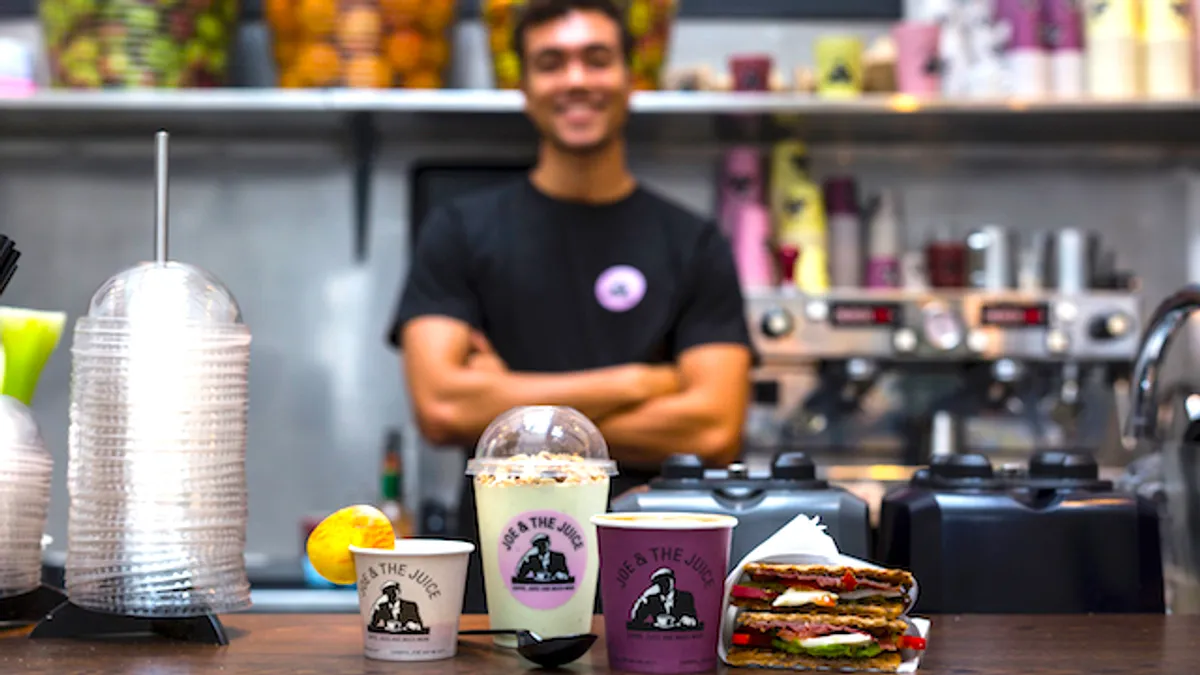Dive Brief:
-
Danish health food chain Joe & the Juice might go public by the end of 2019, reported Bloomberg. Majority-owned by a Stockholm-based private equity firm and in part by a U.S. firm, the hip coffee and juice company aims for a valuation of $1.5 billion.
-
At its nearly 300 stores, two-thirds of which are in northern Europe, Joe & the Juice hopes to align itself with contemporary global brands like Shake Shack, which has gained nearly 150% since going public in 2015. The listing would end a more than three-year hiatus in restaurant IPOs above $50 million.
-
Started by CEO Kaspar Basse in a department store in 2002, Joe & the Juice doubled its revenue to $396 million from 2012 to 2016, jumpstarted by Valedo Partners’ $48 million buyout in 2013. In October 2016, Greenwich, Connecticut firm General Atlantic joined as a minority partner, supplying enough capital for the company to open 150 U.S. stores this year.
Dive Insight:
A 2019 IPO would place the trendy chain in the same camp as a Shake Shack, which recently announced expansion into Mexico and Latin America. In the U.S. especially, Joe & the Juice wants to peel customers away from Starbucks and Pret A Manger, the U.K. coffee and sandwich chain with 92 U.S. locations. Similar to the private equity takeover of Joe & the Juice, in May Pret accepted a $2 billion offer from JAB Holdings — the owner of Krispy Kreme and Panera — to aid in U.S. expansion.
It’s difficult to say how well Joe & the Juice will fare outside of urban markets, and competition in the $40 billion coffee market remains fierce. Starbucks continues to add to its industry-leading benefits package and Dunkin’ wants to shake its donut image and win the price game for espresso drinks. McDonald’s has lost ground in the breakfast field, where it controls almost 15% of sales, but it has definitely focused marketing dollars on maintaining that share. Joe & the Juice also serves sandwiches on rye ciabatta-like bread, coconut yogurt bowls and fruity milkshakes. It doesn’t seem to vary its menu based on location, which could be a boon to consistent branding or a misstep in disparate markets.
The chain has staked its appeal on young, hip consumers seeking fresh and nutritious choices, but its owner Kaspar Basse, often cites his commitment to employees as the main driver of its success. The company encourages workers to dress how they like and the play the music they want. Its “juicer” competitions have drawn attention for their raucous nature, where employees compete to make juices at record pace while juggling fruit and balancing pitchers on their heads.
The company now operates 57 locations in Denmark, 43 in Sweden and 42 in the U.K. Since entering the U.S. market in 2016, it’s opened stores in New York City, San Francisco, Miami and recently Chicago. Similar to Shake Shack’s growth in the Middle East and Asia before the U.S., Joe & the Juice has opened several stores in Australia, South Korea and Singapore.
The U.S. juice craze hit its stride in the late 90s, but it wasn’t until about 2010 that celebrities took to the trend and espoused its benefits in magazines and on social media. That partly explains why Joe & the Juice started seeing revenue bumps in 2012. Today, the $2.3 billion juice market has hit some roadblocks, as nutritionists have began questioning the high sugar content of pulverized fruit and even vegetable juice.
But this changing consumer sentiment hasn't stopped Joe & the Juice, which relies on an efficient system for made-to-order juices versus bottled juices packaged earlier in the day. Its growth in the U.S. will add another kink to the tight coffee market and perhaps boost interest in fresh-squeezed juice concepts — particularly in the quick-service sector as customers seek convenient, nutritious options.












